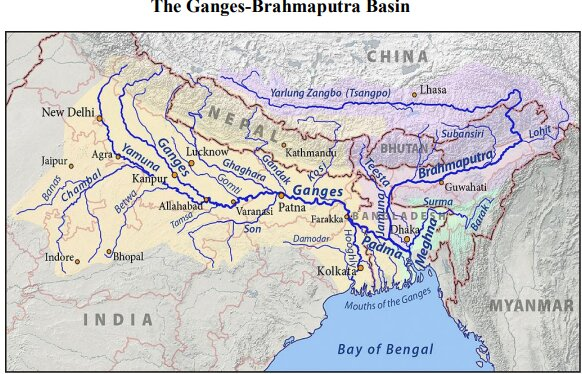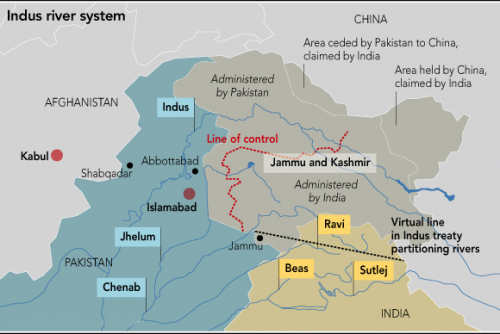Geography
Transboundary Rivers of India
- 28 Aug 2024
- 15 min read
For Prelims: Dambur Dam, Gumti River, Transboundary rivers between India and Bangladesh, National Perspective Plan for Interlinking Rivers, Kosi River.
For Mains: Transboundary Rivers in India and Related Issues, Water Sharing Issues between India and Neighbouring Countries, Water Management.
Why in News?
Bangladesh has recently faced severe floods, leading to concerns that the water might be coming from the Dumbur dam in Tripura, India.
- However, the Indian government has clarified that the flooding is caused by heavy rainfall in the larger catchment areas of the Gumti River, which flows through both nations, rather than the dam’s water release.
Gumti River and Dambur Dam and Dumboor Lake:
- Gumti River:
- It is also known as Gomti, Gumati, or Gomati, which originates in Tripura and flows through the district of Comilla in Bangladesh.
- The right bank tributaries of Gumti river include Kanchi Gang, Pitra Gang, San Gang, Mailak Chhara, and Surma Chhara, while the left bank tributaries are Ek Chhari, Maharani Chhara, and Ganga.
- Dumbur Dam:
- It is built upon the Gumti river in Tripura.
- It is 30 metres in height and generates power that feeds into a grid. Bangladesh draws 40 megawatts (MW) of power from Tripura.
- Dumboor Lake:
- It is situated in Gandacherra, near Agartala and is near the Tirthamukh Hydel Project, the source of the Gomati River.
- Formed by the confluence of the Raima and Sarma rivers, it is known for its diverse fish species.
- The lake hosts the annual 'Poush Sankranti Mela' on 14th January every year.
What are the Transboundary Rivers of India with Neighboring Countries?
- India-Bangladesh: India and Bangladesh share 54 rivers, with India having the most rivers flowing into the Bay of Bengal via Bangladesh. Major rivers are:
-
The Ganges (Padma in Bangladesh): This major river flows from India into Bangladesh, traversing the Gangetic plain of North India.
- Major left-bank tributaries include the Gomti, Ghaghara, Gandak and Kosi.
- Major right-bank tributaries include the Yamuna, Son, Punpun and Damodar.
- Ghaghara: Originating in the Tibetan Plateau, it joins the Ganges near Patna and is notable for its high discharge, especially during the monsoon.
- Son River: Flowing through the Kaimur Range, it covers 487 miles before joining the Ganges above Patna, Bihar.
- In Bangladesh, the Ganges has only one tributary, the Mahananda, while it has distributaries such as the Ichamati, Nabaganga, Bhairab, Kumar, Goari Madhumati, and Arial Khan.
- Teesta: It originates in the Himalayas and flows through Sikkim and West Bengal before merging with the Brahmaputra in Assam and the Jamuna (called Brahamputra in India) in Bangladesh.
- Bangladesh is advocating for a fair allocation of Teesta River waters from India, similar to the Ganga Water Treaty of 1996. However, this request has not been successful.
- The 1996 Ganges Water Treaty between Indian and Bangladesh aimed to resolve disputes between India and Bangladesh over water flow entitlements, which emerged after the Farakka Barrage was built in 1975 to divert Ganges water to the Hooghly River for maintaining Calcutta port.
- Feni: This river flows 135 km south of Agartala, the capital of Tripura. Out of its 1,147 square km catchment area, 535 square km is in India, with the remainder in Bangladesh.
- It forms part of the India-Bangladesh border.
- Maitri Setu, a 1.9 km Long Bridge over Feni River, is constructed in Tripura to link India and Bangladesh.
- Some notable tributaries of the Feni River include the Muhuri River, Raidak River, Chandkhira River, Ryang River, and Kushiyara River.
- Kushiyara River: It is a distributary of the Barak River, originates at the Amlshid bifurcation point on the India-Bangladesh border, where the Barak divides into the Kushiyara and Surma rivers.
- It begins in Assam and gathers tributaries from Nagaland and Manipur.
- Brahmaputra River: It originates from Chemayungdung glacier as the Yarlung Tsangpo in Tibet near Mount Kailash, flows through India and Bangladesh forming a natural border between the two countries.
- It passes through Arunachal Pradesh, Assam, and Meghalaya before entering Bangladesh (called as the Jamuna).
- Major tributaries include the Subansiri, Kameng, Manas, and Dhansiri rivers in India, and the Teesta River in Bangladesh.
- The Brahmaputra River joins the Ganga River in Bangladesh, forming the Padma River, which then merges with the Meghna River and flows into the Bay of Bengal through the Meghna Estuary.
- Meghna: Barak river in India divides into 2 streams Surma and Kushiyara in Karimganj district in Assam. Surma and Kushiyara rejoin at Kishoreganj district in Bangladesh to be known as Meghna.
- Upto Chandpur in Bangladesh, it is known as Upper Meghna and after meeting Padma in Chandpur, it is known as Lower Meghna.
- Jamuna (called Brahmaputra in India): Jamuna is a distributary of Brahmaputra, separating from the mainstream at the point where Brahmaputra meets Teesta in Bangladesh, and flows with the name Jamuna till Goalundo ghat in Bangladesh where it meets Padma river (called Ganga in India).
-
- India-China: The Trans-border rivers flowing from China to India fall into two main groups.
- Brahmaputra River System: The Brahmaputra river system on the eastern side, which consists of river Siang (main stream of river Brahmaputra) and its tributaries, namely Subansiri and Lohit, with the river Brahmaputra called Yaluzangbu or Tsangpo in China; and
- Indus River System: The Indus River system on the western side, consisting of river Indus and the river Sutlej.
- There are two MoUs signed between India and China for provision of hydrological information on these two rivers by China to India.
- India-Pakistan:
- Indus River: The Indus is a trans-boundary river in Asia that originates in Western Tibet, flows northwest through the Kashmir, and then continues south-by-southwest through Pakistan, eventually emptying into the Arabian Sea near Karachi.
- The water of the Indus River and other west-flowing rivers from India has been a contentious issue between India and Pakistan since independence.
- Sutlej: It is a major tributary of the Indus River, originating at Rakas Lake in Pakistan.
- It flows parallel to the Indus for about 400 kilometres, enters India through Himachal Pradesh's Shipki La Pass, and continues through Punjab.
- There, it meets the Beas River, forming part of the India-Pakistan border before joining the Chenab River.
- The combined flow creates the Panjnad River, which empties into the Indus.
- Chenab: It is a major tributary of the Indus River, originating from the confluence of the Chandra and Bhaga streams at Tandi in Himachal Pradesh.
- Known as Chandrabhaga in its upper reaches, it flows west through Jammu and Kashmir and then southwest into Pakistan.
- It descends into the Punjab province's alluvial lowlands and meets the Jhelum River near Trimmu before emptying into the Sutlej River.
- Jhelum:
- Originating from Verinag Spring in the Kashmir Valley, it travels through Jammu and Kashmir and Punjab.
- It passes through Srinagar and Wular Lake, entering Pakistan through a gorge near Gilgit and merging with the Chenab River near Jhang.
- Beas:
- The Beas River originates at Beas Kund near Rohtang Pass in Himachal Pradesh.
- It flows through the Kullu valley and joins the Sutlej River at Harike in Punjab.
- Ravi:
- Ravi River originates at Bara Bangal of Kangra district, Himachal Pradesh, and flows through Bara Bansu, Tretha, Chanota and Ulhansa, covering 158 km before entering Punjab state.
- Its famous tributaries are Budhil, Siul, Baljeri, Chatrari and Baira.
- The 1960 Indus Waters Treaty has allocated control of the Beas, Ravi, and Sutlej rivers to India and the Indus, Chenab, and Jhelum rivers to Pakistan.
- Indus River: The Indus is a trans-boundary river in Asia that originates in Western Tibet, flows northwest through the Kashmir, and then continues south-by-southwest through Pakistan, eventually emptying into the Arabian Sea near Karachi.
- India-Nepal:
- The Kosi and Gandak are major rivers from Nepal that flow into India. Other significant rivers include the Rapti, Narayani, and Kali.
- These rivers, which enter India from Nepal, primarily originate in the Tibetan Plateau and the Himalayan ranges.
- Kosi:
- The Kosi River, a transboundary river flowing through China, Nepal, and India, is a major tributary of the Ganges.
- Originating from the confluence of the Sun Kosi, Arun Kosi, and Tamur Kosi in the Himalayas, it flows through Nepal and Bihar before joining the Ganges in Bihar.
- Kosi is known for its frequent course changes and flooding, earning it the nickname "sorrow of Bihar."
- Gandak:
- It is also known as the Gandaki or Narayani River, flows through northern India and Nepal.
- Originating in Tibet near the Nepal border at an altitude of 7,620 metres.
- It passes through Bihar and Uttar Pradesh before merging with the Ganges near Patna.
- Major tributaries include the Mayangadi, Bari, Trisuli, Panchand, Sarhad, and Budhi Gandak.
- Sharda/Kali/Mahakali River:
- It originates at Kalapani in Uttarakhand. It flows along the western border of Nepal and India.
- After merging with the Ghaghra River and passing through the hills as the Kali River, it enters the Terai plains and is known as the Sharda River.
- The Pancheshwar Dam, a joint India-Nepal project for irrigation and hydroelectric power, has been proposed for this river.
- India and Nepal have traditionally disagreed over the interpretation of the Sugauli Treaty 1816, which delimited the boundary along the Maha Kali River in Nepal, with the two countries differing as to which stream constitutes the source of the river.
|
Drishti Mains Question: What are the major transboundary rivers of India? Examine the challenges and opportunities in managing transboundary rivers in India. |
UPSC Civil Services Examination Previous Year Question (PYQ)
Prelims
Q. With reference to river Teesta, consider the following statements: (2017)
- The source of river Teesta is the same as that of Brahmaputra but it flows through Sikkim.
- River Rangeet originates in Sikkim and it is a tributary of river Teesta.
- River Teesta flows into Bay of Bengal on the border of India and Bangladesh.
Which of the statements given above is/are correct?
(a) 1 and 3 only
(b) 2 only
(c) 2 and 3 only
(d) 1, 2 and 3
Ans: (b)
Q. With reference to the Indus river system, of the following four rivers, three of them pour into one of them which joins the Indus directly. Among the following, which one is such a river that joins the Indus direct? (2021)
(a) Chenab
(b) Jhelum
(c) Ravi
(d) Sutlej
Ans: (d)
Q. Consider the following pairs (2019)
| Glacier | River | |
| 1. | Bandarpunch | Yamuna |
| 2. | Bara Shigri | Chenab |
| 3. | Milam | Mandakini |
| 4. | Siachen | Nubra |
| 5. | Zemu | Manas |
Which of the pairs given above are correctly matched?
(a) 1, 2 and 4
(b) 1, 3 and 4
(c) 2 and 5
(d) 3 and 5
Ans: (a)
Mains:
Q1. Present an account of the Indus Water Treaty and examine its ecological, economic and political implications in the context of changing bilateral relations. (2016)
Q2. Discuss the Namami Gange and National Mission for Clean Ganga (NMCG) programmes and causes of mixed results from the previous schemes. What quantum leaps can help preserve the river Ganga better than incremental inputs? (2015)







